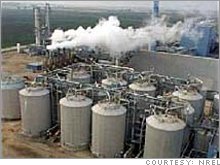|
Even bullish investors wary of ethanol
Is the corn-based fuel a harbinger for the energy market, or just a lot of hogwash?
NEW YORK (CNNMoney.com) - For investors looking to cash in on high energy prices, few sectors have proved as lucrative this year as the ethanol business. Shares of ethanol-related firms have surged since the start of the year, bolstered by a plug from President Bush during his State of the Union address, a phase-out of a chemical-based gasoline additive in favor of the corn-based ethanol and rising fuel prices.
California-based Pacific Ethanol (Research), the company of which Bill Gates recently bought 25 percent, has seen its shares nearly quadruple. Shares in Green Plains Renewable Energy (Research), a Las Vegas, Nevada-based company founded in 2004 to construct a yet-to-be-built ethanol refinery in Iowa, have soared 44 percent. Diversa Corp. (Research), a San Diego-based biotech company that's involved in ethanol production, has watched its shares nearly double and New York-based Xethanol Corp. (Research) stock has more than tripled in value. Even shares in Archer-Daniels-Midland (Research), the grandaddy of ethanol that corners 25 percent of the market but a company that derives much of its income from other agriculture ventures, have jumped 77 percent. Yet barring ADM, only Green Plains has posted a profit in any of the last four quarters. So with these skyrocketing share prices and lack of earnings, is now the time to jump into ethanol? Blinded by hype
The short answer is no. "There is no valuation that makes any sense at all," said Michael Judd, an analyst at Greenwich Consultants that covers Pacific Ethanol. "This is just a bubble situation." Judd, who has a strong sell rating on Pacific Ethanol, said part of the risk to investing in any ethanol company is that the product, a fuel, is a commodity made from corn, another commodity. Therefore the price of both the raw material and the finished product is difficult to predict. "The volatility is tremendous," he said. "There are so many unknowns." Even Paul Resnik, whose employer Dutton Associates is paid by Pacific Ethanol to cover it, doesn't have a buy rating on the stock. Resnik instead opts for a "hold," saying that while ethanol may be a good investment, "it's not the best kept secret." Resnik also said it's easy for lots of companies to get in on the ethanol game with relatively little technical know-how. Ethanol is basically a grain alcohol produced the same way now as it was when first invented sometime before recorded history. That could eventually flood the market with new product, driving down prices. Another obstacle is cost. The spot price for ethanol is currently around $2.80 a gallon, similar to the price of gasoline. Gasoline would have to remain at these record highs, or the price of ethanol would have to drop, for ethanol to continue to be competitive. Not even the manager of a diversified mutual fund had much of an appetite for small-scale domestic ethanol companies. David Schoenwald, who manages the $190-million New Alternatives Fund, said he didn't own any U.S. start-up ethanol companies because the stock price was too high. Drunk on the future
But this doesn't mean ethanol isn't a viable energy source, or investment, in the long run. In addition to its relative ease of production, one problem facing ethanol is that it doesn't yield as much energy given what's required to make it. Although it can be made from a variety of crops, in the U.S. ethanol is made mostly from corn. After the seeds are crushed the meal is then cooked, mostly using natural gas, before it's distilled to make the final product. The American Coalition for Ethanol's Kristin Brekke said it takes about one unit of natural gas to cook two units of ethanol. Other reports have said that, after factoring in the fuel required to till and harvest the fields and the petrochemicals needed to fertilize and keep those fields free of bugs, the return on energy is only 1.3 units of ethanol for every 1 unit of input. But that could change if ethanol producers switch from using the corn kernels to the whole plant, a technology Brekke said was 2 to 10 years away. Then the abundant raw materials -- everything from corn stalks and grass to wood chips and municipal waste -- would help make ethanol more competitive. |
|


